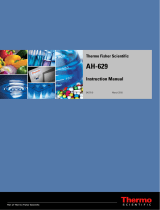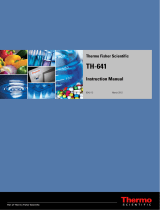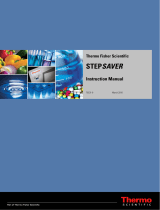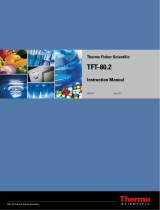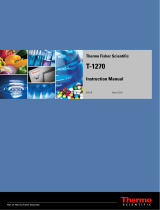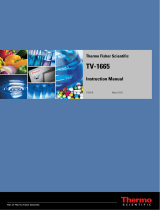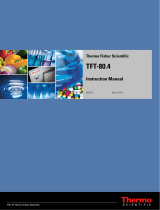Page is loading ...

52274-11 March 2010
Thermo Fisher Scientific
AH-650
Instruction Manual

© 2009 Thermo Fisher Scientific Inc. All rights reserved.
ULTRACRIMP< is either a registered trademark or a trademark of Thermo Fisher Scientific.
All other trademarks are the property of Thermo Fisher Scientific Inc. and its subsidiaries.
Thermo Fisher Scientific Inc. provides this document to its customers with a product purchase to use in the
product operation. This document is copyright protected and any reproduction of the whole or any part of this
document is strictly prohibited, except with the written authorization of Thermo Fisher Scientific Inc.
The contents of this document are subject to change without notice. All technical information in this
document is for reference purposes only. System configurations and specifications in this document supersede
all previous information received by the purchaser.
Thermo Fisher Scientific Inc. makes no representations that this document is complete, accurate or error-
free and assumes no responsibility and will not be liable for any errors, omissions, damage or loss that might
result from any use of this document, even if the information in the document is followed properly.
This document is not part of any sales contract between Thermo Fisher Scientific Inc. and a purchaser. This
document shall in no way govern or modify any Terms and Conditions of Sale, which Terms and Conditions of
Sale shall govern all conflicting information between the two documents.
Release history: 52274-11 printed in March 2010.
For Research Use Only. Not for use in diagnostic procedures.

Thermo Scientific AH-650 i
T
Thermo Scientific AH-650 Rotor ............................................................................................. ii
Important Safety Information ................................................................................................. iii
Chapter 1 DESCRIPTION ........................................................................................................................ 1-1
Rotor Description .................................................................................................... 1-2
Rotor Specifications ................................................................................................. 1-2
Accessories ............................................................................................................... 1-2
Chapter 2 SPECIAL OPERATING CONSIDERATIONS ........................................................................ 2-1
Derating Rotor Speed .............................................................................................. 2-2
Compartment Loads in Excess of Design Mass ........................................................ 2-2
Precautions to Prevent Precipitation of Cesium Chloride ......................................... 2-2
Critical Speed .......................................................................................................... 2-4
Chemical Compatibility .......................................................................................... 2-4
Chapter 3 OPERATION ............................................................................................................................. 3-1
Prerun Safety Checks ............................................................................................... 3-2
Rotor Precool .......................................................................................................... 3-2
Tube Filling and Bucket Loading ............................................................................ 3-2
Rotor Balancing ....................................................................................................... 3-4
Bucket Attachment .................................................................................................. 3-4
Rotor Installation ..................................................................................................... 3-5
Centrifuge/Rotor Log .............................................................................................. 3-5
Chapter 4 Technical Notes .................................................................................................................... 4-1
Relative Centrifugal Force (RCF) Determination .................................................... 4-2
Calculation of Sedimentation Time in Aqueous (Non-gradient) Solutions .............. 4-5
Calculation of Sedimentation Time in Gradient Solutions ...................................... 4-6
Chapter 5 CARE and MAINTENANCE .................................................................................................. 5-1
Corrosion ................................................................................................................ 5-2
Cleaning .................................................................................................................. 5-2
Inspection ................................................................................................................ 5-3
Storage ..................................................................................................................... 5-3
Overspeed Decal Replacement ................................................................................. 5-3
Service Decontamination Policy .............................................................................. 5-4
Chemical Compatibility Chart ...............................................................................A-1
Contact Information ................................................................................................B-1
Table of contents

Thermo Scientific AH-650 ii
P
This manual is a guide for the use of
Thermo Scientific AH-650 Rotor
Data herein has been verified and is believed adequate for the intended use of the centrifuge. Because
failure to follow the recommendations set forth in this manual could produce personal injury or
property damage, always follow the recommendations set forth herein. Thermo Fisher Scientific does
not guarantee results and assumes no obligation for the performance of rotors or other products that
are not used in accordance with the instructions provided. This publication is not a license to operate
under, nor a recommendation to infringe upon, any process patents.
Publications prior to the Issue Date of this manual may contain data in apparent conflict with that
provided herein. Please consider all data in this manual to be the most current.
NOTES, CAUTIONS, and WARNINGS within the text of this manual are used to emphasize
important and critical instructions.
WARNING informs the operator of a hazard or unsafe practice that could result in personal injury,
affect the operator's health, or contaminate the environment.
CAUTION informs the operator of an unsafe practice that could result in damage of equipment.
NOTE highlights essential information.
© 1994, 1997, 1999, 2010 by Thermo Fisher Scientific
CAUTION and WARNING are accompanied by a hazard symbol and appear near the
information they correspond to.

Preface
iii AH-650 Thermo Scientific
Important Safety Information
Certain potentially dangerous conditions are inherent to the use of all centrifuge rotors. To ensure safe
operation of this rotor, anyone using it should be aware of all safe practices and take all precautions
described below and throughout this manual.
WARNING
When using radioactive, toxic, or pathogenic materials, be aware of all characteristics of
the materials and the hazards associated with them in the event leakage occurs during
centrifugation. In the event of a rotor failure, neither the centrifuge nor the rotor can
protect you from particles dispersed in the air. To protect yourself, we recommend
additional precautions be taken to prevent exposure to these materials,
for example, use of controlled ventilation or isolation areas.
Always be aware of the possibility of contamination when using radioactive, toxic, or
pathogenic materials. Take all necessary precautions and use appropriate decontamination
procedures if exposure occurs.
Never use any material capable of producing flammable or explosive vapors or creating
extreme exothermic reactions.
Never exceed the maximum rated speed of the installed rotor; to do so can cause rotor
failure.
Always reduce (derate) rotor speed as instructed in this manual whenever:
•the compartment load exceeds the maximum allowable compartment load specified.
See Chapter 2, Operation.
Failure to reduce rotor speed under these conditions can cause rotor failure.

Preface
Thermo Scientific AH-650 iv
CAUTION
Do not expose aluminum rotor components to strong acids, bases, or alkaline laboratory
detergents; liquid chlorine bleach; or salts (chlorides) or heavy metals such as cesium, lead,
silver, or mercury. Use of these materials with aluminum can cause a chemical reaction that
initiates corrosion.
Besure to securely lock the rotor to drive before starting a centrifuge run.
Do not operate or precool a rotor at the critical speed, as this will have a detrimental effect
on centrifuge component life. See Chapter 1, Description.
Do not operate centrifuge with a rotor out of balance. Operating the rotor out of balance
can cause damage to the centrifuge drive assembly.
Always maintain the rotor in the recommended manner; do not use rotors showing signs
of corrosion or cracking. See Chapter 3, Care and Maintenance.
Do not autoclave or expose any aluminum rotor parts to temperatures in excess of 100°C.

Thermo Scientific AH-650 1-1
1
DESCRIPTION
This manual provides you with the information you will need to operate and maintain your Thermo
Scientific Rotor. If you encounter any problem concerning either operation or maintenance that is not
covered in the manual, please contact our Marketing Technical Group for assistance. In the United
States, call toll free 1-866-9THERMO. Outside the United States, contact the distributor or agent for
Thermo Fisher Scientific products. Thermo Fisher Scientific product information is available on our
internet web site at http://www.thermo.com/centrifuge .
Contents
•“Rotor Description” on page 1-2
•“Rotor Specifications” on page 1-2
•“Accessories” on page 1-2

1 DESCRIPTION
Rotor Description
1-2 AH-650 Thermo Scientific
Rotor Description
The AH-650 is an aluminum swinging bucket ultracentrifuge rotor that can produce up to six sets of
data during a single run at speeds up to 50,000 rpm.1 Each rotor bucket will hold a centrifuge tube
having a nominal fluid capacity of 5 ml; the buckets are sealed during operation by an O-ring and an
aluminum bucket cap. The buckets attach to the rotor body, each at its own numbered position.
During a centrifuge run, they swing out horizontally and return to a vertical position during
deceleration. A disc with alternative black and reflective segments attached to the bottom of the rotor
provides overspeed protection.
Rotor Specifications
Table 1-1 provides the basic specifications for the AH-650 Rotor.
Accessories
The parts supplied with the AH-650 Rotor ordered with complete accessories, Catalog No. 52071,
are listed in Table 1-1. The AH-650 Rotor can also be purchased with basic accessories only. Catalog
No. 54294, which includes all items listed in Table 1-1 except the tubes.
1Speed in revolutions per minute (rpm) is related to angular velocity, w, according to the following:
Where w = rad/s. All further references in this manual to speed will be designated as rpm.
ω(rpm)=2π
60
------
⎝⎠
⎛⎞ rpm()0.10472()=
Table 1-1.Rotor Specifications
Rotor Type Swinging Bucket
Maximum Speed *
*With tubes filled with a homogeneous solution having an average density of 1.2 g/ml or less
50,000 rpm
Relative Centrifugal Force (RCF) at Maximum Speed:
at rminimum (10.60 cm)
at raverage (8.44 cm)
at rmaximum (6.28 cm)
296,005
235,687
175,369
K Factor at maximum speed 53
Critical Speed 1700 rpm
Number of Buckets 6
Total Capacity (nominal) 30 ml
Total Capacity (actual) **
**With tubes filled to within 3 mm (1/8 in) of the top.
28.8 ml
Tube compartment diameter 1.3 cm (0.5 in)
Tube length (nominal) 5.1 cm (2 in)
Maximum compartment mass (includes bucket, tube and contents) 156.6 g
Diameter 16.5 cm (6.5 in)
Rotor weight including buckets 3.0 kg (6.7 lb)

1 DESCRIPTION
Accessories
Thermo Scientific AH-650 1-3
To order replacement parts or accessories, telephone 1-800-522-7746 in the United States. Outside the
United States contact your local representative for Thermo Fisher Scientific products. Be sure to
provide a description of the part, catalog number, rotor type and serial number.
Table 1-2. Accessories Supplied
Quantity Catalog Number Description
4 boxes 3127 Tubes, Polyallomer 5 ml (nominal) (50/box)
1 set of 6 52072 Buckets, 5 ml
6 63713 O-rings (for rotor buckets)
1 52243 Bucket Rack
1 52258 Bucket Cap Wrench
1 51942 Rotor Storage Stand
1 65937 Vacuum Grease
1 61556 Lubricant
1 51349 Overspeed Decal, 50 000 rpm (extra)
1 52384 Ultraspeed Centrifuge/Rotor Log Book
1 52274 Instruction Manual

Thermo Scientific AH-650 2-1
2
SPECIAL OPERATING CONSIDERATIONS
This chapter provides special operating considerations for Basic Operation.
Contents
•“Derating Rotor Speed” on page 2-2
•“Compartment Loads in Excess of Design Mass” on page 2-2
•“Precautions to Prevent Precipitation of Cesium Chloride” on page 2-2
•“Critical Speed” on page 2-4
•“Chemical Compatibility” on page 2-4

2 SPECIAL OPERATING CONSIDERATIONS
Derating Rotor Speed
2-2 AH-650 Thermo Scientific
Derating Rotor Speed
Because of the stresses that the rotor body and buckets must withstand during centrifugation, it is
necessary to eventually derate the maximum operating speed of the rotor. Specifically, the maximum
speed of 50 000 rpm must be derated to 45 000 rpm after the rotor has been used for 1000 runs. To
know when the rotor speed must be lowered, all runs should be recorded in the Ultraspeed
Centrifuge/ Rotor Log Book supplied with the rotor.
Compartment Loads in Excess of Design Mass
The maximum run speed (50 000 rpm) is based on the recommended design mass that has been
established for the rotor, representing the maximum mass that can be carried in each rotor bucket at
top speed.
To prevent rotor failure, the total contents of each bucket, including the weight of the bucket,
specimen and tube, should not exceed the recommended figure unless the rotor speed is reduced
proportionately.
Strict adherence to the maximum allowable compartment mass or reduced speed is required to
prevent rotor failure. Observe the WARNING on the Safety Information Page in the front of this
manual.
The design mass (that is, the weight of the bucket, tube and contents) for an AH-650 bucket is 45.7
g at 50 000 rpm. This figure is based on the use of a Thermo Fisher Scientific thinwall polyallomer
tube filled with liquid at 1.2 specific gravity. If the specific gravity of the solution is greater than 1.2
g, sue the following formula to determine the reduced speed:
This formula does not apply when using gradients that can precipitate (see below).
Precautions to Prevent Precipitation of Cesium Chloride
Observe the WARNING on reducing rotor speed found in the Safety Information Page in the front
of this manual.
Note After the maximum speed has been derated, the new lowered maximum speed should be used
in all calculations and during all operations for the ensuing 1000 runs. (These runs should also be
recorded in the Ultraspeed Centrifuge/Rotor Log Book). In addition, the overspeed decal on the
bottom of the rotor must be replaced with a new decal (Catalog No. 51351) for the lowered speed
(see page 5-3 for Overspeed Decal Replacement procedure).
WARNING After the rotor has been used for 1000 runs at the derated speed, the rotor
body and any set of buckets used with it should no longer be used. Failure to do so can
cause rotor failure with subsequent loss of sample and damage to the rotor and/ or
centrifuge. Also, if the material being processed is hazardous, the loss of sample may result
in personal injury.
Reduced Speed 50000 rpm 1.2 g/ml
Average Fluid Density
---------------------------------------------------=

2 SPECIAL OPERATING CONSIDERATIONS
Precautions to Prevent Precipitation of Cesium Chloride
Thermo Scientific AH-650 2-3
a. Reducing speed to prevent Precipitation
Maximum speed must be reduced for an average fluid density greater than 1.2 g/ml (square-root
reduction) to prevent excessive hydraulic pressure in the bucket. Although the standard formula (see
page 2-1) pertains to sucrose when material such as cesium chloride (CsCl) is used in an
ultracentrifuge.
When solid, crystalline CsCl forms, it places a density of 4 g/ml at the bottom of each bucket. This
density is dangerously high and can cause the rotor to fail, with subsequent sample loss. Therefore,
cesium chloride solutions must be run at reduced speeds to avoid this precipitation. The allowable
speed is determined by the average density of the CsCl solution and the run temperature. Saturation
limits of CsCl in aqueous solutions are temperature dependent. The solubility limit of 1.86 g/ml at
25°C becomes 1.81 g/ml at 5°C . Figures 2-1 and 2-2 should be used to determine the maximum
operating speed. Curves are given for specific average densities and various percentage fills at 5°C and
25°C that will prevent both precipitation and excessive hydraulic pressure.
Also, figures 2-1 (5°C ) and 2-2 (25°C ) include curves that show the standard speed (square root)
reductions to avoid excessive hydraulic pressure only. The standard, square-root reduction formula
cannot be used when precipitation of CsCl must be considered. For example, standard speed reduction
would allow you to run a full tube of solution with a homogeneous density of 1.70 g/ml at 42 000 rpm
at both the 5°C and 25°C temperature ranges. The graphs show that the highest speed you can run a
cesium chloride solution of this density (1.70 g/ml) is 20 500 rpm at 5°C and 28 300 rpm at 25°C for
a full tube of solution. Similarly, if you were to run a cesium chloride solution with a homogeneous
density of 1.70 g/ml in a 3/4 filled tube, the highest speed you can run is 23 500 rpm at 5°C or 32 000
rpm at 25°C .
b. The Gradient Shape
The curves in figures 2-3 (5°C ) and 2-4 (25°C ) show the gradient shape at equilibrium for tubes filled
with a CsCl solution using the homogeneous density and speeds selected from figures 2-1 and 2-2. The
shape of the gradient produced in a partially-filled tube can be determined by using lines 3/4, 1/2 and
1/4 fills. For example, figure 2-1 indicates that a 3/4-filled tube with a 1.70 g/ml homogeneous CsCl
solution cannot be run any faster than 23 300 rpm at 5°C. Figure 2-3 shows the gradient profile of this
tube, 1.61 g/ml at the meniscus to 1.81 g/ml at the bottom of the tube. The shape of the gradient curve
in figure 2-3 can be interpolated between the 20 000 rpm curve and the 25 000 rpm curve. Particle
locations can be determined using the particle density and the gradient shape curves. For example, to
locate a band of particles having a specific density of 1.62 g/ml in 3/4-filled tube run at 23 300 rpm at
5°C,the particles will band 0.3 ml below the 3/4-fill line of the tube (refer to figure 2-3). Similarly,
figure 2-2 shows the same solution in a 3/4-filled tube cannot be run as faster than 32 000 rpm at
25°C. Figure 2-4 shows the gradient profile of this tube, 1.56 g/ml at the meniscus to 1.86 g/ml at the
bottom of the tube. The shape of the gradient curve in figure 2-4 can be interpolated between the 30
000 rpm curve and the 35 000 rpm curve. To locate a band of particles having a specific density of 1.62
g/ml in a 3/4-filled tube run at 32 000 rpm at 25°C, the particles will band just below the 3.0 ml line
or 0.9 ml from the 3/4-fill line of the tube (refer to figure 2-4).
.
Note The top portion of the fluid column in a partially-filled tube is assumed to have an overlay of
1.0 g/ml density or less. (Polyallomer and cellulose nitrate tubes must be filled to within 3 mm of
the top to prevent the tube from collapsing during centrifugation).

2 SPECIAL OPERATING CONSIDERATIONS
Critical Speed
2-4 AH-650 Thermo Scientific
Critical Speed
The critical speed is that speed at which any rotor imbalance will produce a driving frequency equal
to the resonant frequency of the rotating system (that is, the rotor and the centrifuge drive). At this
speed, the rotor may produce large amplitude vibrations which can be felt in the instrument frame.
Mass imbalance will contribute to increased vibration intensity at the critical speed. Operation at the
critical speed of 1700 revolutions per minute (rpm) will have a detrimental effect on centrifuge
component life and therefore, should be avoided.
Chemical Compatibility
The critical components of the AH-650 Rotor apt to come in contact with solution are: rotor body
(aluminum), rotor buckets (titanium), bucket caps (aluminum), O-rings (Viton䉸), and the material
of the tubes used.
The chemical compatibility of rotor elements and accessory materials is given in the Appendix.
Because no organized chemical resistance data exists for materials under the stress of centrifugation,
this data is intended to be used only as a guide. When in doubt, we recommend pretesting of sample
lots.

2 SPECIAL OPERATING CONSIDERATIONS
Chemical Compatibility
Thermo Scientific AH-650 2-5
Figure 2-1. CsCl Precipitation Curve, 17 ml Buckets, 5°C

2 SPECIAL OPERATING CONSIDERATIONS
Chemical Compatibility
2-6 AH-650 Thermo Scientific
Figure 2-2. CsCl Gradients at Equilibrium, 17 ml Buckets, 5°C

2 SPECIAL OPERATING CONSIDERATIONS
Chemical Compatibility
Thermo Scientific AH-650 2-7
Figure 2-3. CsCl Precipitation Curve, 20 ml Buckets, 5°C

2 SPECIAL OPERATING CONSIDERATIONS
Chemical Compatibility
2-8 AH-650 Thermo Scientific
Figure 2-4. CsCl Gradients at Equilibrium, 20 ml Buckets, 5°C

2 SPECIAL OPERATING CONSIDERATIONS
Chemical Compatibility
Thermo Scientific AH-650 2-9
Figure 2-5. CsCl Precipitation Curve, 36 ml Buckets, 5°C

2 SPECIAL OPERATING CONSIDERATIONS
Chemical Compatibility
2-10 AH-650 Thermo Scientific

Thermo Scientific AH-650 3-1
3
OPERATION
This chapter provides step-by-step operating instructions for Basic Operation.
Contents
•“Prerun Safety Checks” on page 3-2
•“Rotor Precool” on page 3-2
•“Tube Filling and Bucket Loading” on page 3-2
•“Rotor Balancing” on page 3-4
•“Bucket Attachment” on page 3-4
•“Rotor Installation” on page 3-5
•“Centrifuge/Rotor Log” on page 3-5
/
